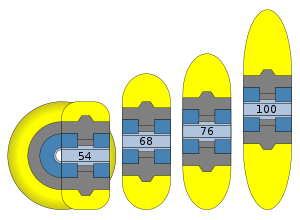From Wikipedia, the free encyclopedia
Inline skates [commonly called, "Roller Blades"] are a type of roller skate, used for inline skating. Unlike quad skates which have a configuration of 2 wheels in the front and 2 wheels in the back, inline skates have two, three, four or five wheels arranged in a single line. Some inline skates, especially those used for recreation, have a "stop" or "brake" which is used to slow down while skateboarding; most inline skates have a heel stop rather than the toe stop, particularly indispensable for Inline Figure Skating.
The earliest roller skates were of the inline design, but these were later superseded by quad skates, the design of which made skating curved edges easier.[citation needed]
The modern style of inline skates was developed as a substitute for ice skates, for use by Russian athletes training on solid ground for Olympic long track speed skating events. Life magazine published a photo of American skater Eric Heiden, training for the 1980 Olympics, using such skates on a Wisconsin road.[1]
During the late 1980s and early 1990s, the popularity of inline skates had a strong resurgence, led by the company Rollerblade, Inc. founded by Scott and Brennan Olson in Minneapolis, Minnesota. After the brothers sold the company in about 1984, Rollerblade promoted and popularized inlines, and their skates became so successful that the term "Rollerblades" has become synonymous with "inline skates."[2]
Parts
A skate is composed of a boot, which is worn on the foot. To the boot is attached a frame, which holds the wheels in place. Bearings allow the wheels to rotate freely around an axle. Finally, the rubber brake typically attaches to the frame of the right foot.
There are different types of inline skates for different types of skating such as aggressive skating, speed skating, Inline hockey and artistic inline skating. Those differ in the boots, frames and wheels that are used.
The boot
For most skating a high boot is used, which provides more ankle support and is easier to skate in, particularly for beginners. Speed skaters often use a carbon fiber boot which provides greater support with a lower cut allowing more ankle flexion. For recreational skating a soft boot is used for greater comfort, but many other disciplines prefer a harder boot, either to protect the foot against impact or for better control of the skate. The boot may also contain shock absorbent padding for comfort.
Most aggressive skates use a hard boot or a hard/soft boot for increased support.
The frame
Typical recreational skates use frames built out of high-grade polyurethane (plastic). Low-end department or toy store skate frames may be composed of other types of plastic. Speed skate frames are usually built out of carbon fibre or extruded aluminum (more expensive but more solid), magnesium, or even pressed aluminum, which is then folded into a frame (cheaper but less sturdy).
Carbon fibre frames are expensive but more flexible, making for a smoother ride at the expense of worse power transfer between the leg and the wheels. In general, carbon fibre frames weigh about 160-180 grams. Aluminum can weigh from 170 to 220 grams. Frame length ranges from around 230 mm for short-framed four wheel skates (used for example in inline hockey), up to about 325 mm for a five wheel racing frame.
Bearings
Ball bearings allow the wheels to rotate freely and smoothly. Bearings are usually rated on the ABEC scale, a measure of the manufactured precision tolerance, ranging from 1 (worst) to 9 (best) in odd numbers. The ABEC standards were originally intended for high-speed machinery, not skating applications, and do not account for the quality of steel used, which is also important. While higher rated bearings are generally better in overall quality, whether they automatically translate to more speed is questionable[3].
The vast majority of skate bearings on the market are produced in China, and tend to be of much lower quality and durability than bearings produced in Japan, Germany, Switzerland, Canada, or the USA. Newer bearings on the market now use ceramic ball bearings instead of steel, the merits of which have yet to be determined.
Wheels
Wheel sizes vary depending on the skating style:
- 44-59 mm for aggressive skating.
- 68-72 mm for artistic inline skating.
- 47-80 mm for roller hockey skating.
- 72-80 mm for freestyle slalom skating.
- 72-90 mm for general recreational skating.
- 84-110 mm for speed skating.
In general the bigger the wheel, the faster the skate. However, large wheels take more energy to start rolling. Smaller wheels allow faster acceleration, maneuverability, and a lower center of gravity. Wheel hardness is measured on the A scale (see Durometer) and usually ranges between 78A-93A (higher numbers are harder). Harder wheels are faster and more durable, but soft wheels may have better grip (grip is determined by many factors, and wheel manufacture is arguably more important than durometer) and less affected by road bumps. Wheel profiles and thicknesses again vary by application. Elliptic profiles minimise friction for a faster ride; more rounded profiles have better grip and are more stable.
Brakes
A hard rubber brake is typically attached to the heel of the frame. Brakes allow for skaters to bring themselves to a stop. Learning how to use the heel brake thus is crucial for beginners.
The heel brakes can interfere with a useful technique called crossover turn (when a skater crosses one leg over another to make a sharp turn without losing much speed), which is why some users prefer not to use them. Skaters who have chosen freestyle slalom and aggressive skating disciplines also tend not to use them because it limits their ability to perform tricks effectively.




No comments:
Post a Comment